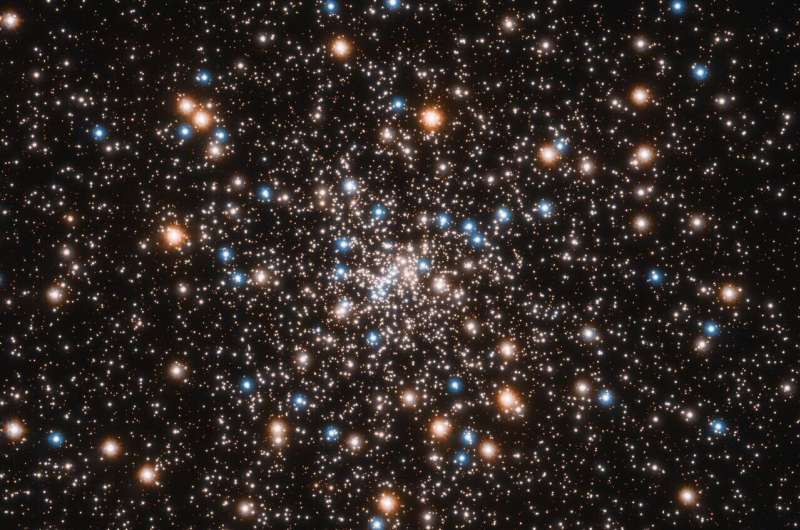
Globular clusters are extremely dense stellar systems, in which stars are packed closely together. They are also typically very old—the globular cluster that is the focus of this study, NGC 6397, is almost as old as the Universe itself. It resides 7800 light-years away, making it one of the closest globular clusters to Earth. Because of its very dense nucleus, it is known as a core-collapsed cluster.
When Eduardo Vitral and Gary A. Mamon of the Institut d'Astrophysique de Paris set out to study the core of NGC 6397, they expected to find evidence for an 'intermediate-mass' black hole (IMBH). These are smaller than the supermassive black holes that lie at the cores of large galaxies, but larger than stellar-mass black holes formed by the collapse of massive stars. IMBH are the long-sought missing link in black hole evolution and their mere existence is hotly debated, although a few candidates have been found.
To look for the IMBH, Vitral and Mamon analyzed the positions and velocities of the cluster's stars. They did this using previous estimates of the stars' proper motions from Hubble images of the cluster spanning several years, in addition to proper motions provided by ESA's Gaia space observatory, which precisely measures the positions, distances and motions of stars. Knowing the distance to the cluster allowed the astronomers to translate the proper motions of these stars into velocities.
"Our analysis indicated that the orbits of the stars are close to random throughout the globular cluster, rather than systematically circular or very elongated," explained Mamon.

"We found very strong evidence for invisible mass in the dense central regions of the cluster, but we were surprised to find that this extra mass is not point-like but extended to a few percent of the size of the cluster," added Vitral.
This invisible component could only be made up of the remnants (white dwarfs, neutron stars, and black holes) of massive stars whose inner regions collapsed under their own gravity once their nuclear fuel was exhausted. The stars progressively sank to the cluster's center after gravitational interactions with nearby less massive stars, leading to the small extent of the invisible mass concentration. Using the theory of stellar evolution, the scientists concluded that the bulk of the unseen concentration is made of stellar-mass black holes, rather than white dwarfs or neutron stars that are too faint to observe.
Two recent studies had also proposed that stellar remnants and in particular, stellar-mass black holes, could populate the inner regions of globular clusters.
"Our study is the first finding to provide both the mass and the extent of what appears to be a collection of mostly black holes in a core-collapsed globular cluster," said Vitral.
"Our analysis would not have been possible without having both the Hubble data to constrain the inner regions of the cluster and the Gaia data to constrain the orbital shapes of the outer stars, which in turn indirectly constrain the velocities of foreground and background stars in the inner regions," added Mamon, attesting to an exemplary international collaboration.
The astronomers also note that this discovery raises the question of whether mergers of these tightly packed black holes in core-collapsed globular clusters may be an important source of gravitational waves recently detected by the Laser Interferometer Gravitational-Wave Observatory (LIGO) experiment.
Citation: Hubble uncovers concentration of small black holes (2021, February 11) retrieved 12 February 2021 from https://ift.tt/3acF6ZQ
This document is subject to copyright. Apart from any fair dealing for the purpose of private study or research, no part may be reproduced without the written permission. The content is provided for information purposes only.
https://ift.tt/3d4kqF8
Science
No comments:
Post a Comment